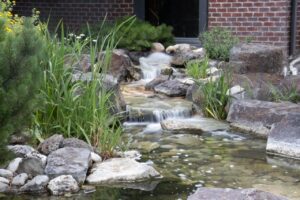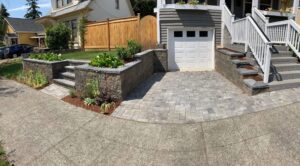Paver patios can come in an infinite number of gorgeous arrangements and can be made with a variety of different materials—a term known as hardscaping. You can make all shapes and sizes of paver patios from small, quaint outdoor arrangements to large, elaborate outdoor setups that would be perfect for hosting, or just kicking your feet up with the family. In doing your research on different styles of paver patios, you may have noticed that many paver patios tend to share some of the same themes and accouterments. If you are interested in building your own paver patio, there are several essential elements that all outdoor areas should include.
1) Seating Area
The first and perhaps the most important items that you are going to need on your paver patio is a comfortable seating area. A paver patio is meant to be a relaxing escape that you can have within the vicinity of your own home. You may want to look into several different seating options including benches, chairs, and loungers. Depending on the aesthetic that you are trying to create with your patio, you may select a variety of different seating options to give this outdoor area some added flair and comfort.
2) Grill
Another favorite use for a quality paver patio is for grilling. One of the best parts about having this enjoyable outdoor space is using it to enjoy cooking outdoors. Your patio is the ideal outdoor space that you can use to enjoy the fresh air while you are grilling for your family and friends.
3) Fire Pit
In looking at dozens of different designs and layouts for paver patios, you may notice that many of them have some type of centerpiece, that brings this outdoor space together. One of the most common centerpieces that you see on paver patios are firepits. What makes fire pits wonderful for outdoor patios is that they are perfect for just about any time of year. Having a fire pit in the summer is great for roasting marshmallows and keeping the bugs away. It is perfect for keeping you warm while you enjoy the crisp winter air.
4) Water Feature
If you are in fact going down the route of looking for the perfect centerpiece for your paver patio, you may also want to take a look at adding a water feature. Though these are traditionally more costly in terms of money and the time that you are spending in maintenance, a nice water feature is a great way to set off the entire area. Not only is adding a water feature to your outdoor area absolutely stunning, in giving your paver patio an added level of vibrancy, they are also incredibly peaceful. We would advise that you take your time in exploring the various types of water features that you can add to your patio area before you make a final decision.
5) Tables
Another one of the most common pieces of furniture that you will see on a nice paver patio are tables. Tables can combine several of the different elements that we are taking a look at today, and can easily be the centerpiece of your patio, and/or cover the entire seating area of the patio. If you are planning on adding a grill to your paver, a table could be the perfect addition to your outdoor area so that you can cook outdoors and eat outside as well. They are the perfect place to enjoy your coffee in the morning or your dinner in the evening, and they serve as a great place to host your family and friends.
6) Umbrellas
Whether you have a table or just a general seating area on your patio, you may also want to look into adding some umbrellas. Umbrellas are both an excellent design component and functional piece of any outdoor area. They look great, and they will keep you cool while you are enjoying your outdoor space in the middle of summer.
7) A Nice View
This is part of your paver patio that you can’t buy in a store. If you have a nice view around your home, be sure to plan the arrangement and organization of your patio around it. Your patio is the perfect way to enjoy the outdoors and nature, and making sure that you fit your paver to the natural beauty around you is critical for creating the perfect outdoor environment, and years of great memories to come.
8) A Path
Last but not least, adding a path to your paver patio can be another functional and beautiful element to add to your outdoor patio space. Much of how you design and set up the path from your home or elsewhere to your paver patio is going to depend on the distance that you have to close and the vibe that you want to create. A direct path can be just as gorgeous as a winding path that leads to and from your paver.
Tools and Materials You Need for Building Your Paver Patio
Assembling the right tools is the first step to making your backyard paver patio ideas come to life.
Patio Material
The biggest hurdle in building a paver patio is finding the perfect material. Cheap paver patio ideas rely on inexpensive materials like concrete for a simple but elegant design. On the other hand, brick paver patio ideas can create a stunning design at a higher cost.
Painter’s Tape
Paver patio projects can get out of hand quickly without definitively set boundaries. Painter’s tape can help you section off a manageable area for your patio and keep your simple paver patio ideas small scale.
Reference Photos
Even small paver patio ideas are hard to visualize without proper references. While working, looking at reference pictures can help you craft your perfect outdoor hangout area.
Tips for Choosing the Right Paver Patio Design Ideas
Choosing the Right Location
One of the best ways to settle on the perfect paver patio idea is to find the ideal location. You want your patio to fit in with its environment without standing out. Selecting a site first will help you narrow down design options to only those that match the area’s surroundings.
Selecting a Paver Color
Your color scheme is the most significant influence on how your paver patio will look and feel. Like location, you want to select a color scheme that will match the patio’s surroundings. For example, a muted color like gray, one of the most popular concrete paver patio ideas, can give your outdoor space a relaxed feeling.
Considering the Texture for Your Brick Pavers
While the difference between the textures is subtle, carefully examining all of them can give you a better idea of how you want your patio to look. Different textures also have functional benefits like slip resistance.
Choosing Your Paver Design
When you’ve decided on the location for your paver patio and the color and texture of the material, you can start considering the layout. Figuring out the ideal paver patio pattern can be challenging, but perfectly arranging the building materials is vital to the area’s overall appearance.
Popular Brick Paver Patio Design Ideas
Brick paver patios are among the most popular outdoor features for backyards. Some of the most popular designs for these patios include:
- Herringbone – features pavers at right angles, forming a V-shaped pattern
- Basket Weave – features two parallel vertical bricks, then two parallel horizontal bricks, and so on
- Ashlar – features small and large square pavers and small rectangular pavers in a repeating pattern
- Random Ashlar – uses the same pavers as an ashlar pattern, but arranged randomly rather than in a repeating pattern
Conclusion
When you’re ready to transform your backyard, cheap paver patio ideas may help, but it can still be hard to carry out your ideas on your own. When you need help building the perfect paver patio, call on the team at New Life Rockeries to handle the job. Contact us today for a free quote!



